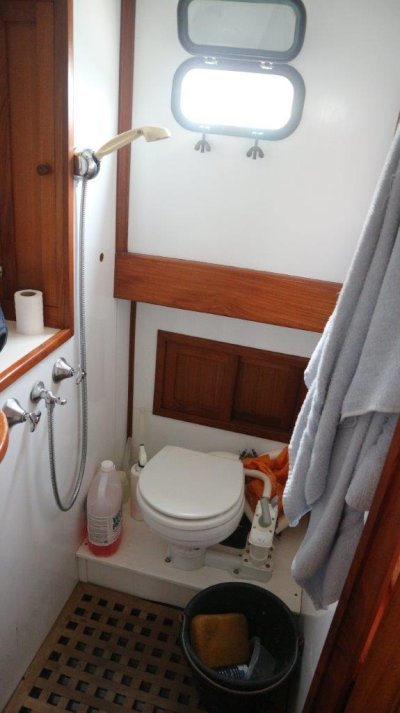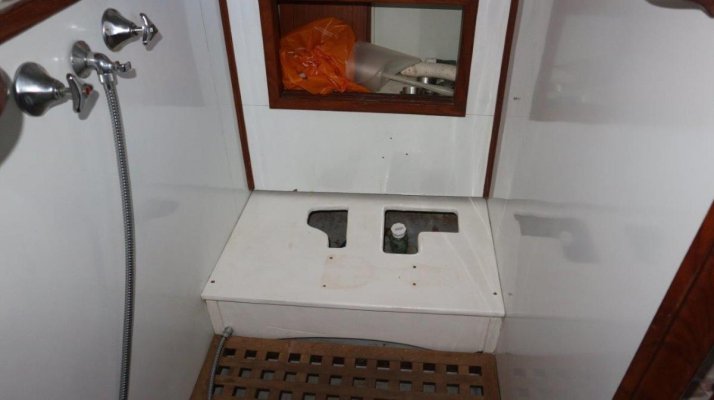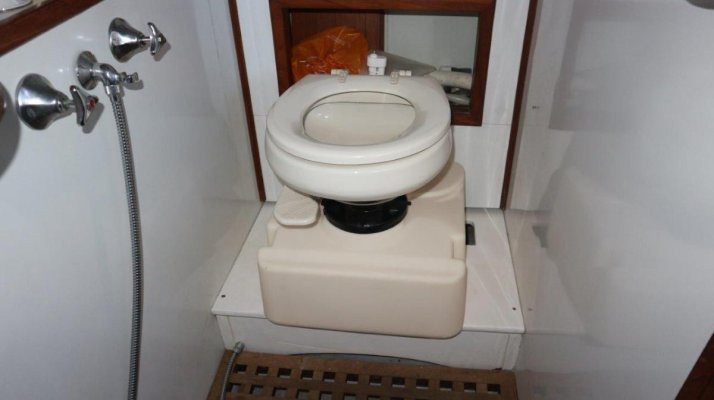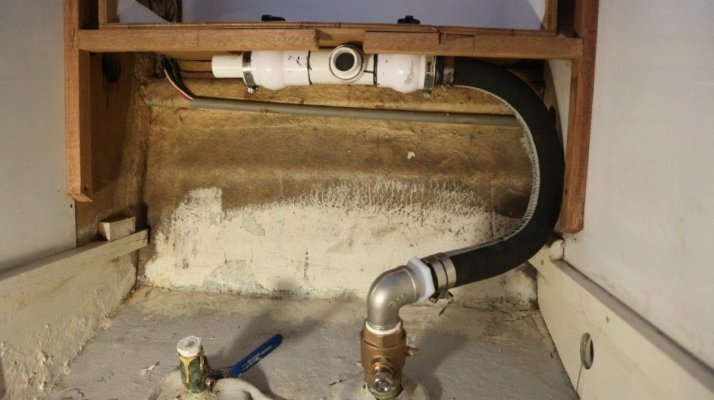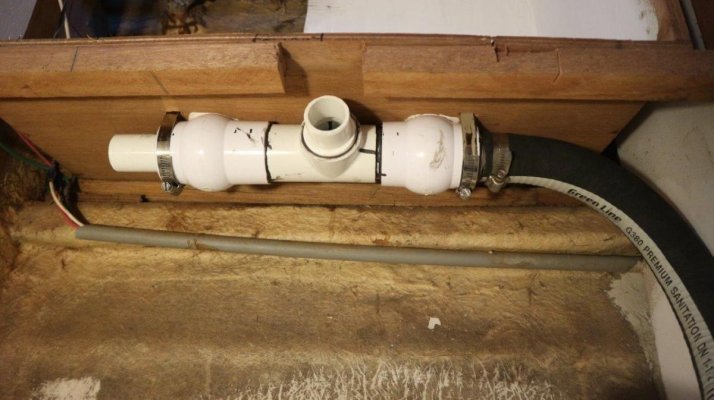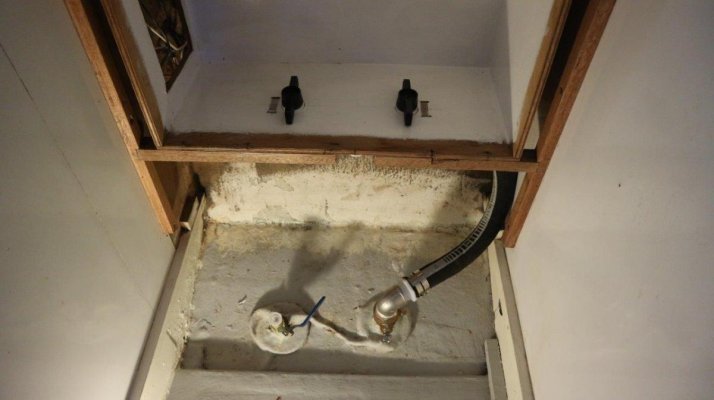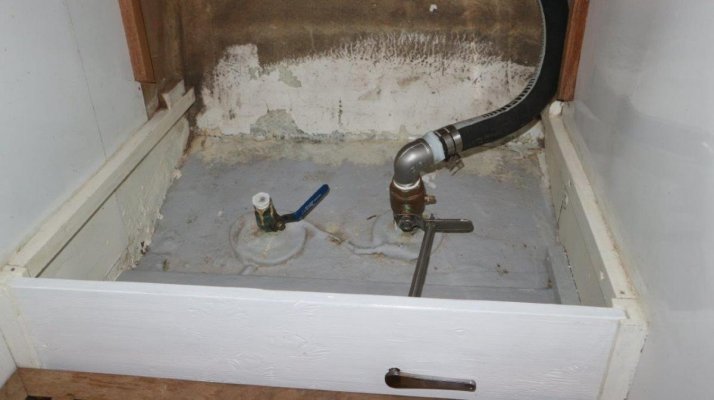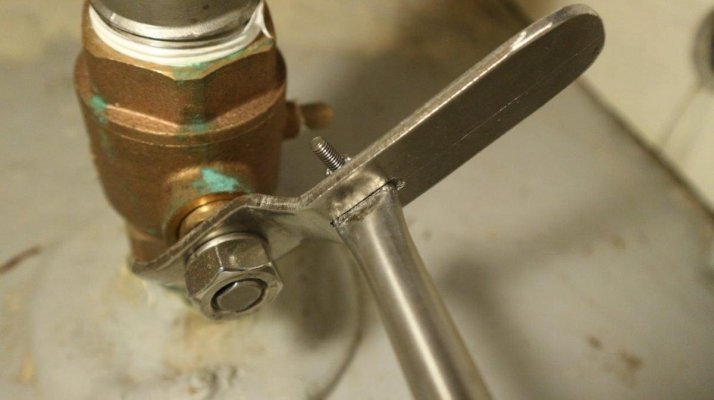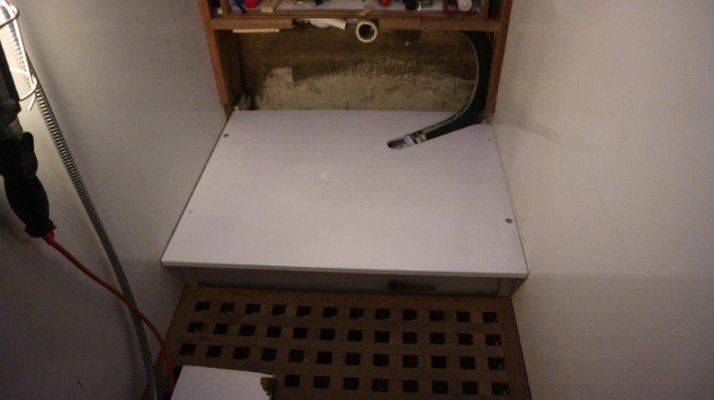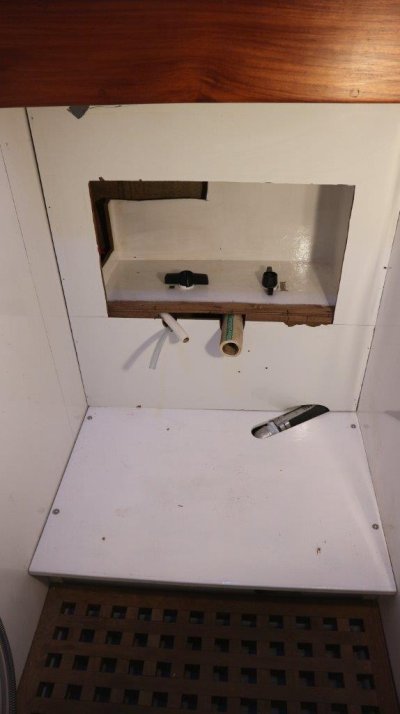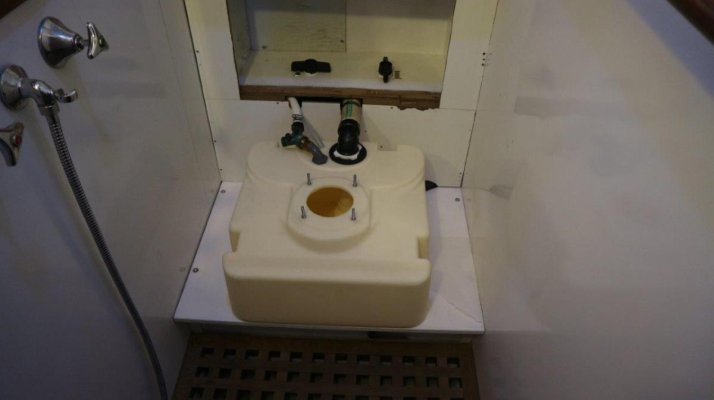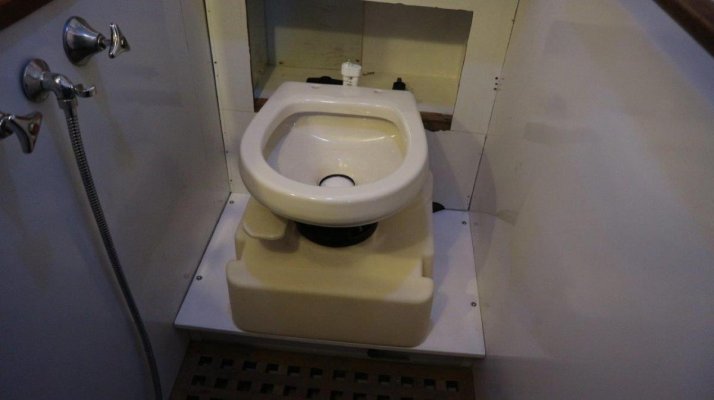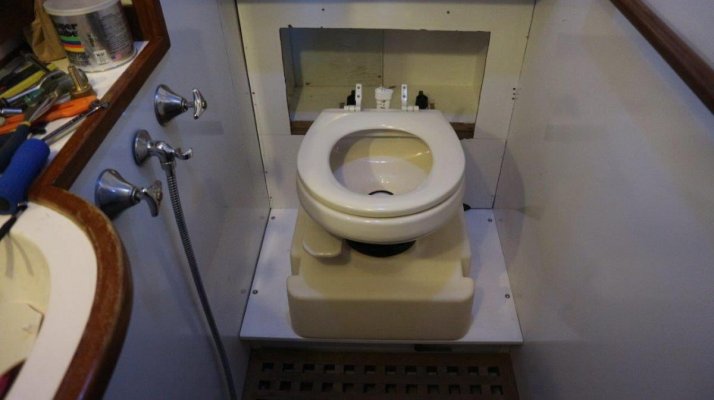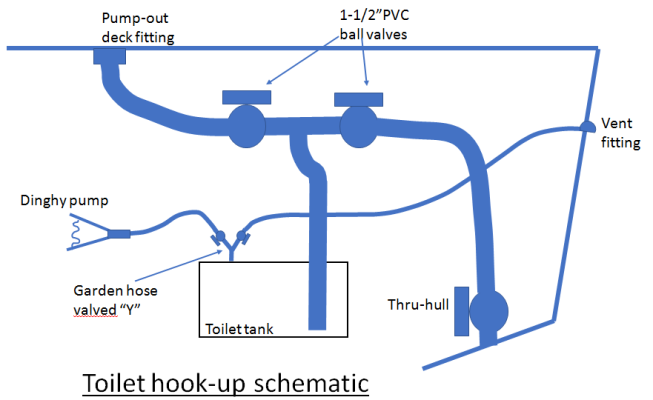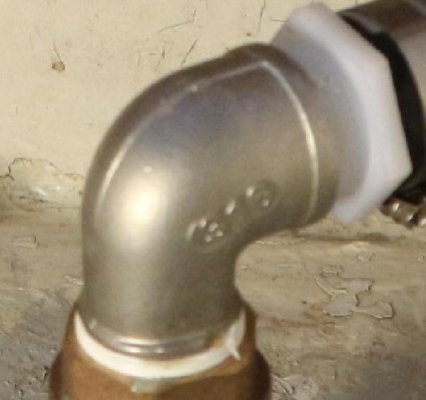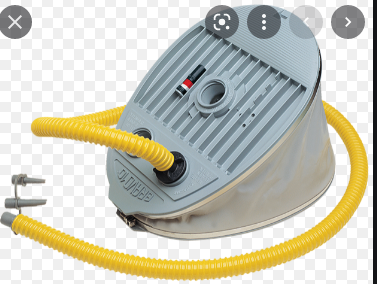Nick F
Guru
- Joined
- Sep 2, 2020
- Messages
- 598
- Location
- Canada
- Vessel Name
- Callisto
- Vessel Make
- 1974 Grand Banks 42 Classic, Hull 433
First - thanks to Peggy for making me aware of the existence of this type of toilet. I had recently purchased the boat (a 1976 CHB34) and the existing sanitation system was totally seized up and needed completely replacing. I threw out holding tanks, macerators and toilets and started again.
The target was to have one functional, legal head for the 2021 season. Here in Vancouver our yacht club has several outstations with shore facilities, so I did not need enormous holding capacity. Plus, the gravity toilet uses a minimal quantity of flush water compared to installations where the waste has to be transported horizontally to a separate holding tank. I also liked the ability to use fresh water for flushing, thereby reducing odours and corrosion.
I planned to be able to empty the built-in holding tank by pump-out and by overboarding via the original underwater thru-hull (when far enough from land). For this I decided on the attached schematic. Included in this proposed design was the plan to overboard by pressuring the tank vent with air. In this way, no pumping of the waste is required (no macerators, no diaphragm pumps).
I should mention that I do not put any paper into the sanitation systems on my boats. All paper goes into a tidy and gets disposed of ashore.
The new toilet was a tight fit in the space, but it was possible. One immediate problem was that the new tank covered the access to the old overboard thru-hull and this required some DIY to make a remote lever to operate the valve. An immediate 90 degree piping turn was also required.
I used two PVC swimming pool type valves to direct the waste to overboard or to the pump-out fitting and was able to install these under the bottom of the tiny cabinet directly behind the toilet. The valve handles are accessible inside the cabinet.
The tank vent was fitted with a garden hose type "Y" which has a small valve in each branch. This permits the vent to be isolated so that the tank can be pressured with air. For pressuring I used my dinghy bellows pump.
Results to date:
The toilet has had relatively light use so far, but has been totally satisfactory. It is nice to not wake up the whole marina when paying a nocturnal visit.
The overboarding with the dinghy pump seems a bit Rube Goldberg but does in fact work fine. I was concerned that the bowl valve might leak too much but this was not a problem. After overboarding I then flush the tank with a gallon or two of fresh water using the hand held shower and overboard again.
Although the final photo does not show the seat lid in place, I was indeed able to install this and a horizontal bungee cord holds it in the up position when required.
I have not suffered odour problems, although the Y fitting does somewhat restrict the vent hose at that point. If this becomes an issue I plan to add a second vent, connected to a fitting on the opposite side of the boat.
As for the PVC isolation valves, the system would work without them, although there would be longer dead legs. It was a lot of work to include them and I would be tempted to eliminate them on a future arrangement.
To date I have not used the pump-out.
Would I recommend this toilet? Yes, if it fits your cruising profile. For me it works as advertised. The bowl appears to be made of quality porcelain and the plastic tank base is very solid. (No affiliation!)
Nick, Jan 2022
Photos:
1 Original toilet
2 Original toilet removed - thru-hull valve visible
3 Trial fit of new toilet
4 Hosing from thru-hull to PVC valves
5 PVC valves mounted under cabinet
6 PVC valve handles inside cabinet
7 Extension for actuating thru-hull valve
8 Detail of thru-hull valve extension
9 New ply base in place
10 Ready for toilet connection
11 Toilet base connected
12 Toilet bowl mounted
13 Final view (lid and cabinet trim missing)
The target was to have one functional, legal head for the 2021 season. Here in Vancouver our yacht club has several outstations with shore facilities, so I did not need enormous holding capacity. Plus, the gravity toilet uses a minimal quantity of flush water compared to installations where the waste has to be transported horizontally to a separate holding tank. I also liked the ability to use fresh water for flushing, thereby reducing odours and corrosion.
I planned to be able to empty the built-in holding tank by pump-out and by overboarding via the original underwater thru-hull (when far enough from land). For this I decided on the attached schematic. Included in this proposed design was the plan to overboard by pressuring the tank vent with air. In this way, no pumping of the waste is required (no macerators, no diaphragm pumps).
I should mention that I do not put any paper into the sanitation systems on my boats. All paper goes into a tidy and gets disposed of ashore.
The new toilet was a tight fit in the space, but it was possible. One immediate problem was that the new tank covered the access to the old overboard thru-hull and this required some DIY to make a remote lever to operate the valve. An immediate 90 degree piping turn was also required.
I used two PVC swimming pool type valves to direct the waste to overboard or to the pump-out fitting and was able to install these under the bottom of the tiny cabinet directly behind the toilet. The valve handles are accessible inside the cabinet.
The tank vent was fitted with a garden hose type "Y" which has a small valve in each branch. This permits the vent to be isolated so that the tank can be pressured with air. For pressuring I used my dinghy bellows pump.
Results to date:
The toilet has had relatively light use so far, but has been totally satisfactory. It is nice to not wake up the whole marina when paying a nocturnal visit.
The overboarding with the dinghy pump seems a bit Rube Goldberg but does in fact work fine. I was concerned that the bowl valve might leak too much but this was not a problem. After overboarding I then flush the tank with a gallon or two of fresh water using the hand held shower and overboard again.
Although the final photo does not show the seat lid in place, I was indeed able to install this and a horizontal bungee cord holds it in the up position when required.
I have not suffered odour problems, although the Y fitting does somewhat restrict the vent hose at that point. If this becomes an issue I plan to add a second vent, connected to a fitting on the opposite side of the boat.
As for the PVC isolation valves, the system would work without them, although there would be longer dead legs. It was a lot of work to include them and I would be tempted to eliminate them on a future arrangement.
To date I have not used the pump-out.
Would I recommend this toilet? Yes, if it fits your cruising profile. For me it works as advertised. The bowl appears to be made of quality porcelain and the plastic tank base is very solid. (No affiliation!)
Nick, Jan 2022
Photos:
1 Original toilet
2 Original toilet removed - thru-hull valve visible
3 Trial fit of new toilet
4 Hosing from thru-hull to PVC valves
5 PVC valves mounted under cabinet
6 PVC valve handles inside cabinet
7 Extension for actuating thru-hull valve
8 Detail of thru-hull valve extension
9 New ply base in place
10 Ready for toilet connection
11 Toilet base connected
12 Toilet bowl mounted
13 Final view (lid and cabinet trim missing)

